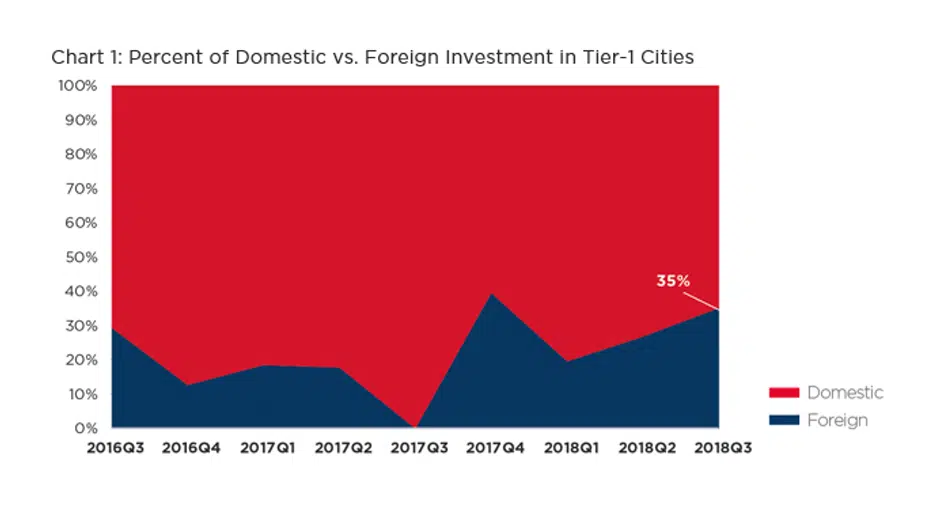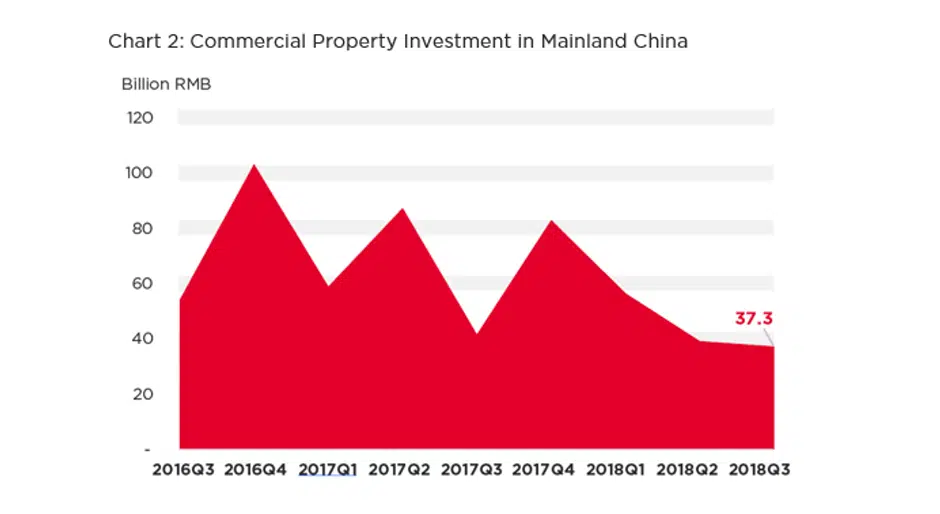Foreign real estate investment returns as overseas capital targets China
Commercial property investment demand from foreign participants rebounded during the third quarter 2018, especially in Tier-1 cities despite an overall softening of investment in Mainland Chinese commercial property over the past 12 months, according to Cushman & Wakefield Research’s latest Greater China Capital Markets Express report.
“Due to the prevailing low yields in China’s core/core-plus asset categories, buyers continue to look for value-added investments in Tier-1 cities,” said Francis Li, international director and head of capital markets, Greater China at Cushman & Wakefield. “Such strategies include the acquisition of underperforming assets for upgrade or conversion. Examples of this might include retail to office uses — especially co-working — and grade B office to rental apartments. In addition, ongoing improvement in both intra- and inter-city connectivity attracts more capital to target real estate assets in emerging CBDs in Tier-1 cities and some leading Tier-2 cities.”
The increased share of foreign investment in China came amid a challenging lending environment for Chinese domestic investors. Shanghai has been the primary target of foreign capital, recording RMB23.5 billion ($3.4 billion) in property investment over the first three quarters of 2018, surging 83 percent year-over-year. Industrial properties in Hong Kong attracted increased demand from investors given the city’s drive for industrial revitalization. In Taipei, investment was led by office and industrial-office (I/O) deals, particularly older office buildings in the core areas of the city with stable income and redevelopment potential.
“Investment activity in Mainland China is expected to pick up over the next 12 months,” said James Shepherd, managing director of research, Greater China at Cushman & Wakefield. “However, given the prevailing tight lending situation, projected new office supply is likely to fall back, while end-user demand remains strong. Overall office vacancy rates in China, particularly in Tier-2 cities, have tightened and this seems set to continue through 2019. For those investors with strong asset management capability and access to debt, we forecast an increasingly attractive commercial real estate investment environment for office blocks or development projects in peripheral areas of Tier-1 cities or core areas of strong Tier-2 cities.”
Catherine Chen, head of forecasting & capital markets research, Greater China at Cushman & Wakefield, added, “Government initiatives, including the Greater Bay Area, Belt & Road and urban renewal schemes, are expected to continue to drive growth of commercial real estate investments in China. In addition, strong expansion of the services sector, driven by the rise of Chinese companies, is forecast to continue to support office occupier demand, providing promising investment prospects for quality office assets in China’s core markets.”
The report provides insights on the following hot topics:
Express Railway Ushering in Growing Opportunities in Guangzhou, Shenzhen and Hong Kong: The opening of the long-anticipated Express Rail Link in September marks an exciting milestone in the ongoing development of the Greater Bay Area (GBA). Three locations are expected to reap huge benefits in particular: the areas surrounding Shenzhen’s Futian Station, Guangzhou South Railway Station and Hong Kong West Kowloon Station.
Other Investment Opportunities in the Greater Bay Area (GBA): From a regional perspective, each of the cities under the GBA framework have their own strengths. For example, secondary cities Foshan, Zhuhai, Dongguan and Zhongshan will become regional core cities, while Huizhou, Zhaoqing and Jiangmen will likely become large logistics hubs given their geographical advantages.
Asset Management for Conversion Projects: As investors seek new ways to squeeze value from China’s real estate market, property conversions are one attractive prospect. A notable example of this is the hotel-to-office repurposing of the Shanghai JC Mandarin Hotel into a modern class A office tower. With a program of extensive works, the ongoing conversion involves significant design and structural engineering, in addition to numerous governmental approvals.
In addition, the report identifies key investment themes in Greater China’s core investment markets:
Beijing: Beijing’s investment market witnessed a rebound in third quarter 2018, following a cooling through the first half of 2018. A total of RMB11.9 billion ($1.7 billion) worth of investment changed hands during the quarter, up 13 percent y-o-y. E-commerce companies became increasingly active, as reflected by JD’s RMB2 billion ($290 million) acquisition of the 68,000-square-meter (732,000-square-foot) Beijing Jade Hotel.
Shanghai: Shanghai’s investment market recorded 17 deals at a combined consideration of RMB18.09 billion ($2.6 billion) for the quarter. Activity by foreign investors has surged amid the increasing challenges faced by domestic investors, including strict deleveraging requirements and fewer funding channels. Notable foreign investments included Brookfield’s purchase of Mall Jinqiao and Mall Jiading for RMB1.38 billion and RMB560 million ($200 million and $80 million), respectively.
Guangzhou: In the first three quarters of 2018, Guangzhou’s investment market recorded a total transaction volume of RMB12 billion ($1.7 billion), up 9.8 percent compared to the same nine-month period last year. Office properties remained the preferred asset class in Guangzhou. Notable transactions included a government institution’s purchase of Building A2, Greenland Central Plaza for RMB1.2 billion ($170 million).
Shenzhen: Shenzhen recorded RMB3.9 billion ($560 million) of investment in third quarter, amounting to RMB10.7 billion ($1.54 billion) through the first three quarters of 2018. Domestic owner-occupiers, traditionally one of the most active buyers of Shenzhen office assets, have remained cautious this year given financial tightening. The purchase of four floors in International Chamber of Commerce Tower in Futian CBD by a Hong Kong investor marked the largest office transaction in the submarket so far this year.
Hong Kong: Despite ongoing U.S.-China trade tensions, investment activity in Hong Kong’s industrial market surged to HKD6.71 billion ($860 million) in third quarter, outpacing the five-year historical quarterly average investment level by 89 percent. Decreasing industrial inventory and the potential reactivation of the government’s industrial revitalization scheme contributed to investors’ ongoing interest in en-bloc industrial buildings.
Taiwan: Taiwan’s commercial property investment market recorded NT$9.6 billion ($319 million) in transaction volume in third quarter. Investment was led by office and industrial-office (I/O) deals. Most office deals involved older office buildings in the core areas of the city with stable income and redevelopment potential.



